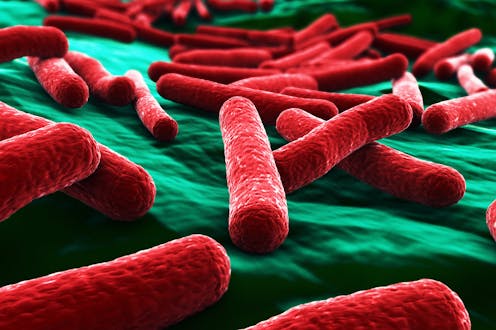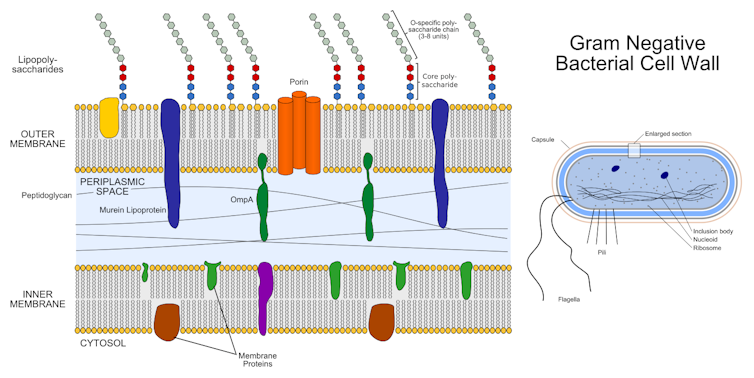Why are some _E. coli_ deadly while others live peacefully within our bodies?
E. coli bacteria are the frequent culprits behind outbreaks of food-borne illnesses. But not all strains are harmful; some are even helpful.

E. coli outbreaks hospitalize people and cause food recalls pretty much annually in the United States. This year is no different.
Obviously some E. coli can be deadly for people. But not all strains of these bacteria make you sick. In fact, you have a variety of strains of E. coli in your intestines right now – including one that’s busy making the antioxidant vitamin K, crucial for your and its survival.
Scientists like me often characterize E. coli by the sugar coat they display on their cell surface. A molecule called a lipopolysaccharide is the anchor that displays a collection of sugars to their environment.
These sugars help the bacteria stick to surfaces and reveal their identity to your immune system. Human cells do this, too – your blood type is defined by sugars displayed on your blood cells, for instance.
The sugars E. coli display vary from strain to strain. Some sugar coats are associated with strains living symbiotically in your stomach – E. coli HS, UTI89 and CFT073 are some of the most commonly found to be helpful. Others are associated with illness – like E. coli O104:H4, also called enterohemorrhagic E. coli (EHEC), which caused a major outbreak in Europe in 2011. According to the CDC, this latest outbreak is due to E. coli O157:H7 – a strain that’s caused at least one food-borne outbreak in the U.S. each year since 2006.

The letters and numbers that name a strain serve as a code for which sugars are present. While the sugars bacteria display aren’t what makes you sick, they’re quickly and easily detectable and help scientists and doctors differentiate whether a present strain will generate toxins that can make you ill.
Bacteria rely on what researchers term virulence factors: molecules that aid their survival while undermining your immune system. Both the EHEC and O157 strains of E. coli are able to make a virulence factor called a Shiga toxin. Shiga toxins were discovered first in Shigella dysenteriae, the bacterium that causes dysentery. Later researchers discovered that the EHEC and O157 strains of E. coli had gained the gene for Shiga toxins from the dysentery bacterium through a process called horizontal gene transfer.
When bacteria reach a critical mass in your body after you eat a contaminated food, they secrete these toxins as part of their strategy for finding a new host. The toxins enter the cells of your intestines, causing symptoms including low-grade fever, stomach cramps, diarrhea (often bloody) and vomiting.
It’s virulence factors like these that are to blame for human illnesses and that give E. coli a bad name – even if all strains don’t deserve it.
Erika A. Taylor receives funding from the National Institutes of Health (NIH).
Read These Next
How the ‘slayer rule’ might play a role in determining who will inherit wealth from Rob Reiner and h
These rules have a long history in the United States. They played a role in the notorious murders by…
The world risks forgetting one of humanity’s greatest triumphs as polio nears global eradication − 7
Polio may finally be defeated in the next 5 years. Will the world recognize what an extraordinary achievement…
RFK Jr. wants to scrutinize the vaccine schedule – but its safety record is already decades long
Federal officials are questioning the safety of the vaccine series children receive. Here’s the story…






